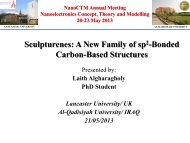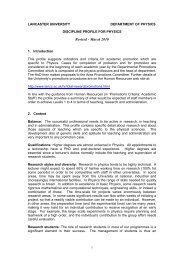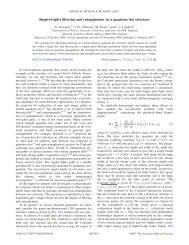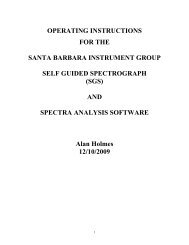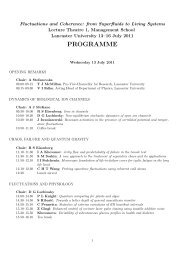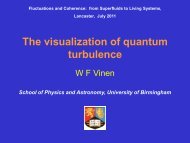Experiments on counterflow and pure superflow turbulence in ...
Experiments on counterflow and pure superflow turbulence in ...
Experiments on counterflow and pure superflow turbulence in ...
You also want an ePaper? Increase the reach of your titles
YUMPU automatically turns print PDFs into web optimized ePapers that Google loves.
<str<strong>on</strong>g>Experiments</str<strong>on</strong>g> <strong>on</strong> <strong>counterflow</strong> <strong>and</strong> <strong>pure</strong> <strong>superflow</strong><br />
<strong>turbulence</strong> <strong>in</strong> superfluid 4He<br />
New cryohall <strong>in</strong> Prague<br />
S. Babu<strong>in</strong>, T. Chagovets, M. Rotter, M. Stammeier<br />
<strong>and</strong> L. Skrbek<br />
Jo<strong>in</strong>t Low Temperature Laboratory,<br />
Faculty of Mathematics <strong>and</strong> Physics,<br />
Charles University &<br />
Institute of Physics ASCR<br />
V Holešovičkách 2, 180 00 Prague 8, Czech Republic<br />
Fluctuati<strong>on</strong>s <strong>and</strong> Coherence:<br />
from Superfluids to Liv<strong>in</strong>g Systems<br />
Lancaster, UK, 13-16 July 2011
Thermal <strong>counterflow</strong> <strong>in</strong> He II<br />
Two-fluid model (L<strong>and</strong>au)<br />
W.F. (Joe) V<strong>in</strong>en,<br />
55 years ago…<br />
V<br />
V<br />
N<br />
N<br />
<br />
<br />
N<br />
Q<br />
AST<br />
<br />
V<br />
S<br />
<br />
s<br />
Experimental observati<strong>on</strong>: quantized vortices attenuate sec<strong>on</strong>d sound
Counterflow tangle – courtesy of Makoto Tsubota
,<br />
However....<br />
Heat transport efficiency<br />
<br />
Ra<br />
<br />
13 /<br />
1/3<br />
T<br />
Q<br />
Nu<br />
' <br />
Q<br />
2<br />
Vortex l<strong>in</strong>e density<br />
L<br />
Q<br />
2
Counterflow <strong>turbulence</strong> phenomenology (V<strong>in</strong>en 1957)<br />
2b<br />
Vortex r<strong>in</strong>g<br />
v<br />
t<br />
8b<br />
ln<br />
<br />
4b<br />
a<br />
1<br />
4<br />
<br />
<br />
<br />
<br />
<br />
b<br />
T 0<br />
F<strong>in</strong>ite T<br />
In <strong>counterflow</strong>, though, if v v v V<br />
r<strong>in</strong>gs with exp<strong>and</strong><br />
t<br />
n<br />
s<br />
CF<br />
v t<br />
b b<br />
Dimensi<strong>on</strong>al analysis <strong>and</strong> analogy with classical fluid dynamics leads to the V<strong>in</strong>en equati<strong>on</strong>:<br />
dL B n<br />
3/ 2 2<br />
L – voxtex l<strong>in</strong>e density<br />
1 VCFL<br />
2<br />
L ( g(<br />
VCF))<br />
dt 2 <br />
m<br />
Reproduced by Schwarz (1988) –<br />
4<br />
computer simulati<strong>on</strong>s<br />
producti<strong>on</strong> decay<br />
rec<strong>on</strong>necti<strong>on</strong>s<br />
V CF<br />
For steady there is a steady value of L<br />
Early results reviwed by J.T. Tough Turbulent states I, II, III<br />
c<br />
Decay of <strong>counterflow</strong> <strong>turbulence</strong>:<br />
dL<br />
dt<br />
<br />
<br />
<br />
m<br />
2<br />
2<br />
L<br />
4<br />
L<br />
t<br />
<br />
1 Numerous<br />
t <br />
t VO<br />
experiments <br />
(V<strong>in</strong>en, Schwarz, Milliken…)
Turbulent states TI <strong>and</strong> TII<br />
Allen <strong>and</strong><br />
Reekie rule<br />
Two transiti<strong>on</strong>s<br />
observed <strong>in</strong> <strong>counterflow</strong> <strong>in</strong> circular <strong>and</strong><br />
small aspect ratio rectangular channels<br />
•temperature difference<br />
•pressure difference<br />
•sec<strong>on</strong>d sound attenuati<strong>on</strong><br />
•But <strong>on</strong>ly <strong>on</strong>e <strong>in</strong> th<strong>in</strong> channels
Thanks to many <strong>in</strong>vestigators, especially to V<strong>in</strong>en, Tough,<br />
Sim<strong>on</strong>, D<strong>on</strong>nelly, Glabers<strong>on</strong>, Schwarz, Barenghi ….<br />
a fair level of underst<strong>and</strong><strong>in</strong>g of <strong>counterflow</strong> <strong>turbulence</strong> <strong>in</strong> He<br />
II has been achieved by the end of eighties <strong>and</strong> almost all<br />
work has been term<strong>in</strong>ated<br />
Still, puzzles rema<strong>in</strong><br />
•Anomalous decay of <strong>counterflow</strong> <strong>turbulence</strong><br />
•Nature of turbulent states TI, TII, TIII<br />
(<strong>in</strong> particular, is the <strong>counterflow</strong><strong>in</strong>g normal fluid turbulent)<br />
•Relati<strong>on</strong>ship to classical <strong>turbulence</strong><br />
•......
Prague sec<strong>on</strong>d sound counterfow experiments<br />
gold-plated<br />
nuclepore membrane<br />
Lock-<strong>in</strong><br />
A0<br />
A<br />
S<br />
generator<br />
Brass electrode<br />
heater<br />
Three different CF channels:<br />
L<br />
<br />
6<br />
s <br />
B<br />
<br />
<br />
A<br />
0<br />
A<br />
<br />
1<br />
<br />
C9 S7 S10
Sec<strong>on</strong>d sound amplitude (10 -4 V)<br />
Sec<strong>on</strong>d sound signal - <strong>counterflow</strong> <strong>turbulence</strong><br />
Can we treat our data <strong>on</strong> decay<strong>in</strong>g<br />
<strong>counterflow</strong> <strong>turbulence</strong> as isothermal <br />
Yes<br />
Direct measurement of the temperature<br />
difference across the channel<br />
Simple model for decay<strong>in</strong>g temperature<br />
gradient when the heater is switched off<br />
(Gordeev, Chagovets, Soukup, Skrbek, JLTP 138 (2005) 554)<br />
heater <strong>on</strong><br />
heater off<br />
time (s)<br />
1. Initial fast decay<br />
2. Intermediate –slow - stage<br />
3. Late power law decay
Grid <strong>turbulence</strong> <strong>in</strong> He II -<br />
Oreg<strong>on</strong> decay experiments<br />
Decay of <strong>counterflow</strong><br />
<strong>turbulence</strong> <strong>in</strong> He II<br />
Late decay of vortex l<strong>in</strong>e density<br />
(vorticity) both <strong>in</strong> grid-generated <strong>and</strong><br />
<strong>counterflow</strong>-generated He II <strong>turbulence</strong><br />
displays the classical exp<strong>on</strong>ent of -3/2
After saturati<strong>on</strong> of the energy-c<strong>on</strong>ta<strong>in</strong><strong>in</strong>g length scale – universal decay law<br />
Dependence <strong>on</strong> the channel size experimentally c<strong>on</strong>firmed<br />
for the first time (even for classical <strong>turbulence</strong>)<br />
Gordeev, Chagovets, Soukup, Skrbek,<br />
JLTP 138 (2005) 554)<br />
S10<br />
S7<br />
The late decay -c<strong>on</strong>sistent with<br />
Kolmogorov – type <strong>turbulence</strong><br />
3/ 2<br />
D3C<br />
<br />
L( t) t t<br />
*<br />
<br />
2<br />
eff<br />
<br />
3/ 2<br />
Chagovets, Gordeev, Skrbek,<br />
Phys. Rev. E 76, 027301, 2007.
10 mm x10 mm channel<br />
A puzzle…<br />
Intermediate – anomalously slow<br />
decay<br />
…..resolved<br />
(analytically <strong>and</strong> numerically)<br />
Depolarizati<strong>on</strong><br />
of the vortex tangle
vortex l<strong>in</strong>e density (arbitrary units)<br />
Sec<strong>on</strong>d sound signal<br />
Full Biot-Savart calculati<strong>on</strong>s<br />
As well as LIA approximati<strong>on</strong><br />
0.1<br />
<strong>in</strong> a periodic box 1 cm, T= 2 K<br />
<strong>counterflow</strong> 1 cm/s ,<br />
vortex tangle L=190 cm<br />
Side view of the tangle<br />
x,y-directi<strong>on</strong>s<br />
0.01<br />
0.1 1 10<br />
tim e s<strong>in</strong>ce the heater is off (s)<br />
z-directi<strong>on</strong><br />
Time (s)
Pure <strong>superflow</strong> – early results by Tough’s group<br />
Only <strong>on</strong>e turbulent state !<br />
Experimentally observed<br />
quantity is T-difference<br />
Asht<strong>on</strong>, Tough, PRL46 658(1981)
Critical velocity was found (Baehr <strong>and</strong> Tough, PRL 51 (1983) 2295)<br />
to be 1-2 cm/s <strong>and</strong> was given <strong>in</strong> the dimensi<strong>on</strong>less form of<br />
“superfluid Reynolds number” (<strong>in</strong> analogy with thermal <strong>counterflow</strong>)<br />
Why does <strong>pure</strong> <strong>superflow</strong> differ from thermal <strong>counterflow</strong> <br />
How does it decay <br />
Can we learn someth<strong>in</strong>g more while <strong>in</strong>vestigat<strong>in</strong>g it
Prague <strong>pure</strong> <strong>superflow</strong> setup<br />
(based <strong>on</strong> the founta<strong>in</strong> pump)<br />
He bath level<br />
superleaks<br />
Q<br />
He II
Q <br />
Prague <strong>pure</strong> <strong>superflow</strong> setup<br />
He II<br />
Level<br />
meter<br />
<strong>and</strong> lift<br />
system<br />
Sec<strong>on</strong>d<br />
sound<br />
sensors<br />
v s<br />
Founta<strong>in</strong> effect <strong>in</strong> He II<br />
He II<br />
Ag s<strong>in</strong>tr<br />
heater
Sec<strong>on</strong>d sound amplitude (at res<strong>on</strong>ance) – raw data<br />
heater<br />
On<br />
Off<br />
We know the mean superfluid velocity based <strong>on</strong> the power applied to<br />
the founta<strong>in</strong> pump. Our analysis relies heavilly <strong>on</strong> this formula.
Steady-state data<br />
1.92 K<br />
1.73 K<br />
1.58 K<br />
1.49 K<br />
•On <strong>in</strong>creas<strong>in</strong>g power,<br />
there are three states<br />
•Pure <strong>superflow</strong><br />
L=0<br />
•A - state (known)<br />
•We have discovered<br />
a new B - state<br />
Agrees with<strong>in</strong> error bars with<br />
the data of Baehr <strong>and</strong> Tough
Critical velocity<br />
(cm/s)<br />
(K)<br />
K.W. Schwarz: Phys. Rev. B 18, 245 - 262 (1978)<br />
Our observati<strong>on</strong> of the critical velocity <strong>in</strong><br />
two channels of sizes almost two orders<br />
of magnitude wider agrees with<strong>in</strong> the<br />
error bars with that of Baehr <strong>and</strong> Tough<br />
<strong>and</strong> shows that for <strong>pure</strong> <strong>superflow</strong> (or,<br />
via Galilean transformati<strong>on</strong> also for<br />
homogeneous <strong>counterflow</strong>) “superfluid<br />
Re” scal<strong>in</strong>g does not hold <strong>and</strong> this<br />
critical velocity is an <strong>in</strong>tr<strong>in</strong>sic<br />
property of the self-susta<strong>in</strong><strong>in</strong>g vortex<br />
tangle, <strong>in</strong> accord with the early<br />
c<strong>on</strong>siderati<strong>on</strong>s <strong>and</strong> calculati<strong>on</strong>s of<br />
Schwarz
How to underst<strong>and</strong> the B - State <br />
We believe the key po<strong>in</strong>t is to realize the ability of superfluid to mimic classical flows.<br />
•C<strong>on</strong>sider a classical viscous lam<strong>in</strong>ar flow through a circular pipe of the size of our<br />
channel, with parabolic Poiseuille flow profile<br />
•It results <strong>in</strong> the solenoidal vorticity profile, with the mean<br />
•Assum<strong>in</strong>g that <strong>superflow</strong> mimics this classical behavior, the required vortex l<strong>in</strong>e<br />
density that would be observed by sec<strong>on</strong>d sound must exceed<br />
•This simple physical picture is <strong>in</strong> qualitative agreement with our observati<strong>on</strong>s.<br />
Allow<strong>in</strong>g for the ”slip velocity”, it correctly predicts the l<strong>in</strong>ear behavior <strong>in</strong> the B – state<br />
with temperature <strong>in</strong>dependent <br />
Could we verify such<br />
a scenario <br />
What about the<br />
decay data
Heater off<br />
Decay data<br />
Viscous decay of<br />
such a flow structure<br />
<br />
2k<br />
1 2<br />
With no fitt<strong>in</strong>g parameters these calculated values of effective k<strong>in</strong>ematic<br />
viscosity agree with those deduced from (i) decay<strong>in</strong>g towed grid <strong>turbulence</strong>;<br />
(ii) decay<strong>in</strong>g <strong>counterflow</strong> <strong>turbulence</strong>; (iii) sp<strong>in</strong>-down experiments (Golov);<br />
(iv) theoretical estimates of V<strong>in</strong>en <strong>and</strong> Niemela
Generati<strong>on</strong> of QT<br />
mechanical vs thermal
L 1/2 (cm -1 )<br />
3000<br />
2500<br />
2000<br />
Steady-state vortex l<strong>in</strong>e density<br />
T (K)<br />
1.35<br />
1.45<br />
1.65<br />
1.75<br />
1.95<br />
1500<br />
1000<br />
500<br />
300<br />
200<br />
100<br />
0<br />
0 2 4 6 8 10 12 14 16 18 20 22 24<br />
v (cm/s)<br />
0<br />
0.0 0.5 1.0 1.5 2.0<br />
Critical velocity
350<br />
300<br />
250<br />
A: present work<br />
B: TC & LS (2008)<br />
C: Asht<strong>on</strong> et al. (1981)<br />
D: Schwarz theory (1978)<br />
E: Adachi et al. theory (2010)<br />
200<br />
s/cm 2<br />
150<br />
100<br />
50<br />
0<br />
1.1 1.2 1.3 1.4 1.5 1.6 1.7 1.8 1.9 2.0 2.1<br />
T (K)
L (10 5 cm -2 )<br />
14<br />
12<br />
10<br />
8<br />
A<br />
T(K)<br />
1.35<br />
1.45<br />
1.65<br />
1.75<br />
1.95<br />
6<br />
4<br />
2<br />
1.92 K<br />
1.73 K 1.58 K<br />
1.49 K<br />
B<br />
0<br />
0 2 4 6 8 10 12 14 16 18<br />
v (cm/s)
L (cm -2 )<br />
L (cm -2 )<br />
L (cm -2 )<br />
10 6<br />
T = 1.35 K, 5 samples at flow speed = 15.6 cm/s<br />
Decay data<br />
10 7 steady state<br />
10 6<br />
flow speed<br />
(cm/s)<br />
15.6<br />
10.4<br />
6.9<br />
4.3<br />
10 5<br />
10 4<br />
10 5<br />
10 4<br />
10 3<br />
-3/2<br />
power<br />
10 2<br />
0.1 1 10 100<br />
time (s)<br />
curves smoothened by 25 po<strong>in</strong>t averag<strong>in</strong>g<br />
10 5<br />
T=1.35 K<br />
(1e6)*exp(-(x-1.2)/0.05) + (1e5)*(x^(-1.5))<br />
10 6 T = 1.35 K, 5 samples at flow speed = 15.6 cm/s<br />
Fast <strong>in</strong>itial exp<strong>on</strong>ential<br />
decay, then crossover<br />
to (quasi)classical -3/2<br />
power law decay<br />
10 3<br />
T = 1.35 K<br />
10 2<br />
0.1 1 10 100<br />
t (s)<br />
t -3/2<br />
But: it does not work nearly as<br />
nicely at higher temperatures<br />
0.8 1.0 1.2 1.4 1.6 1.8 2.0 2.2 2.4<br />
time (s)
Summary<br />
• We have experimentally <strong>in</strong>vestigated flow of superffluid 4He restricted to <strong>pure</strong><br />
net <strong>superflow</strong> through the channel, generated both thermally <strong>and</strong> mechanically<br />
• We c<strong>on</strong>firm the existence of weakly temperature dependent critical velocity of order 1<br />
cm/s, which does not scale with the channel size <strong>and</strong> is therefore an <strong>in</strong>tr<strong>in</strong>sic property of selfsusta<strong>in</strong>ed<br />
vortex tangle.<br />
• A new B - state is discovered, characterized by where seems<br />
temperature <strong>in</strong>dependent, however, <strong>on</strong>ly when QT is generated thermally. Mechanical<br />
generati<strong>on</strong> produces quadratic dependence of vortex l<strong>in</strong>e density <strong>on</strong> flow velocity (called A-<br />
state), as <strong>in</strong> thermal <strong>counterflow</strong>.<br />
•Two different states of developed QT can exist <strong>in</strong> <strong>pure</strong> <strong>superflow</strong> !!<br />
•In steady state, they display different vortex l<strong>in</strong>e density as well as its functi<strong>on</strong>al dependence<br />
<strong>on</strong> mean <strong>superflow</strong> velocity (l<strong>in</strong>ear versus quadratic). Moreover, their decays differ drastically<br />
(late exp<strong>on</strong>ential versus classical-like power law decay). Accepted values of effective k<strong>in</strong>ematic<br />
viscosity can be extracted from both these decays, based <strong>on</strong> very different theoretical models.<br />
•A lot of new data measured, <strong>on</strong>ly partly analysed <strong>and</strong> not yet published....<br />
Half a century after the discovery of thermally generated quantum <strong>turbulence</strong><br />
<strong>in</strong> He II there is still plenty of <strong>in</strong>terest<strong>in</strong>g physics to play with…
L (cm -2 )<br />
25 pts adjacent averag<strong>in</strong>g<br />
10 7 t -1 steady state<br />
10 6<br />
10 5<br />
flow speed (cm/s)<br />
9.1<br />
7.8<br />
6.5<br />
5.2<br />
3.9<br />
10 4<br />
10 3<br />
t -3/2<br />
10 2<br />
T = 1.65 K<br />
10 1<br />
0.1 1 10 100<br />
t (s)



